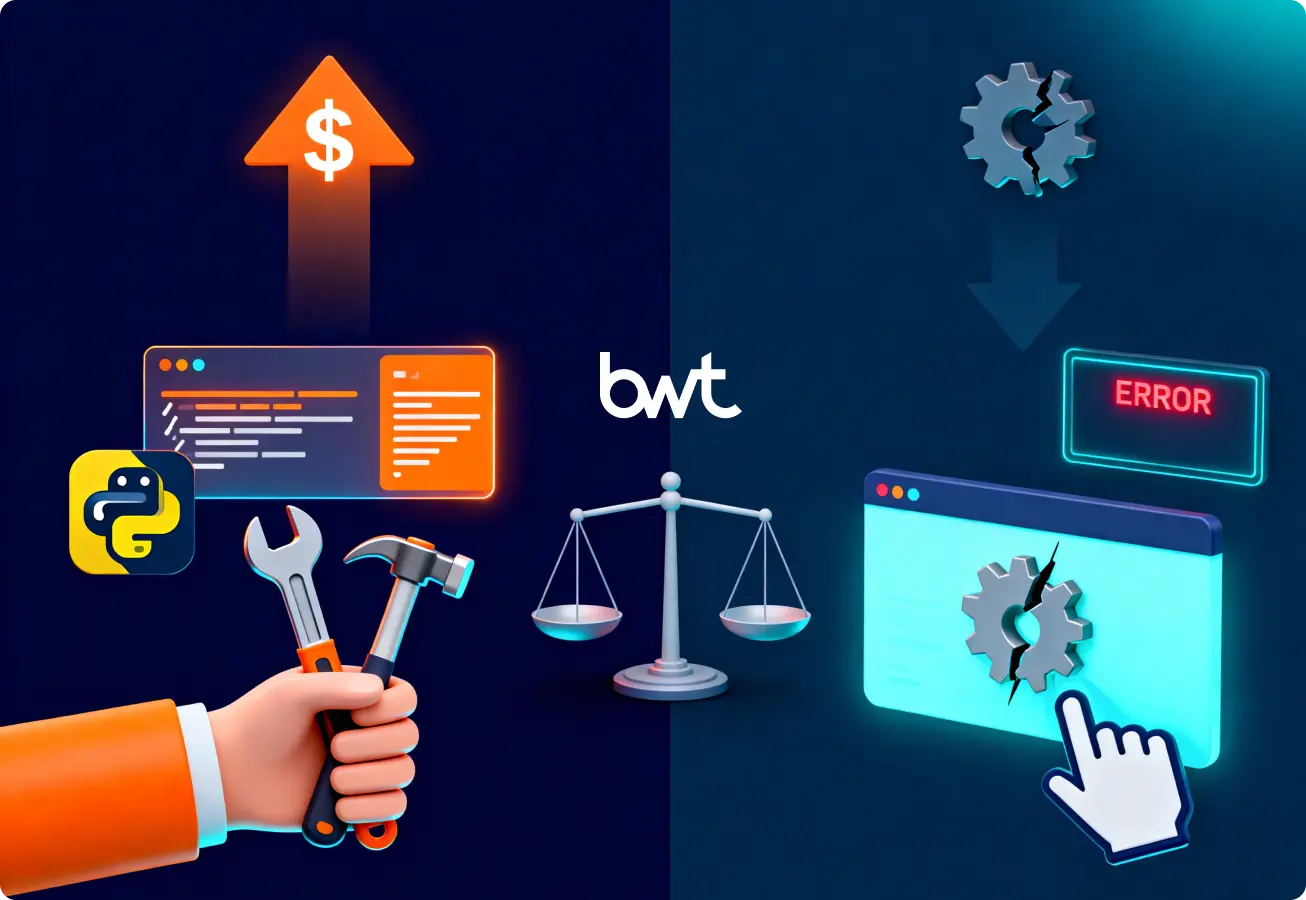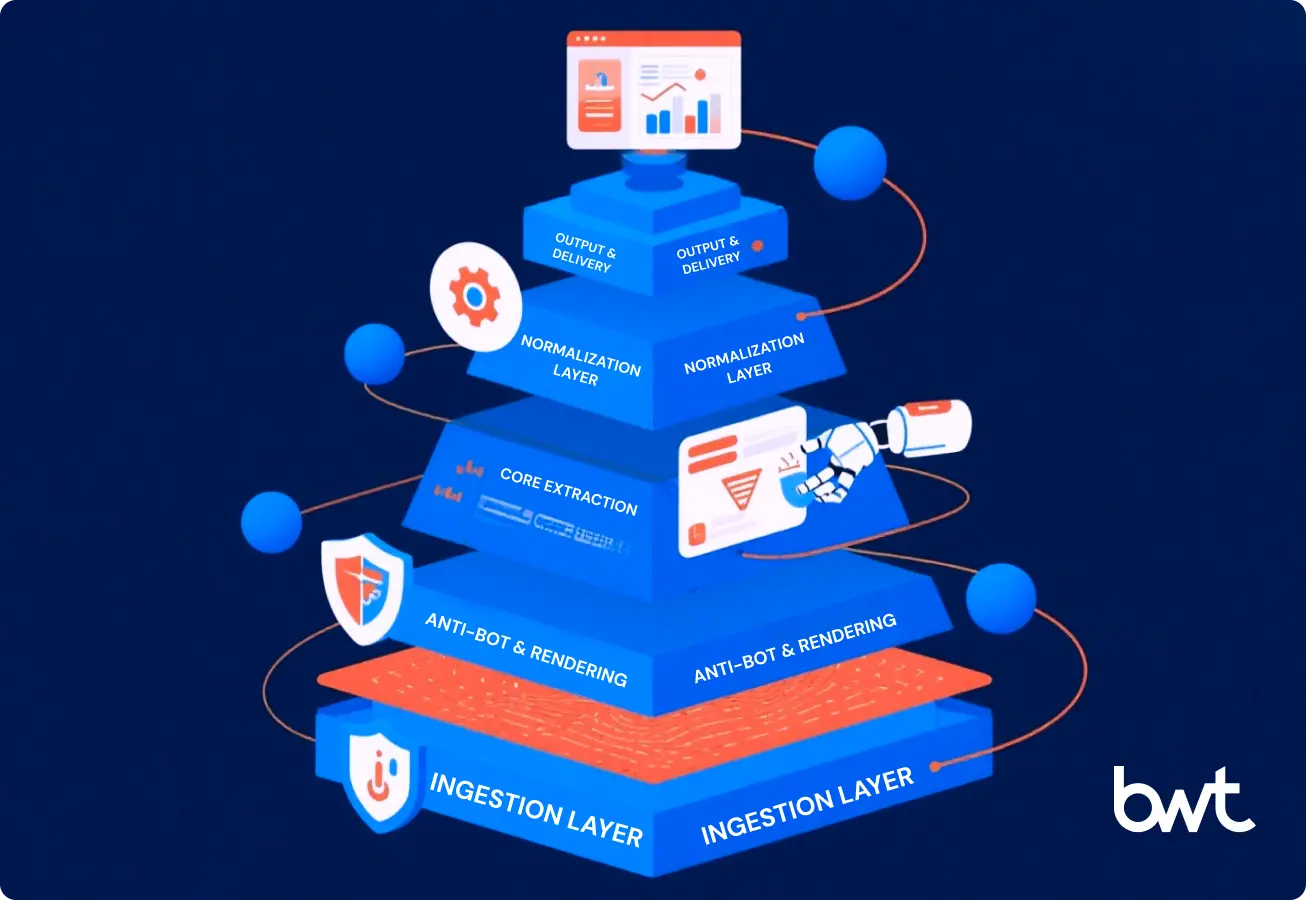Events data scraping directly dictates pricing power. Aggregator apps, pricing tools, and market analysis platforms all depend on accurate, timely event information. This data is fragmented. It sits across thousands of websites, from global platforms like Google to local venue pages. Capturing this data requires a dedicated strategy. This guide examines the technical challenges of event data scraping. We will compare standard methods and outline a framework for building a custom, reliable data architecture.
The Business Value of Event Data: Protecting Margin
Product leaders identify market gaps using event data. Promoters track competitor pricing and schedules. Venues analyze location trends to optimize new openings and preserve capital reserves. Aggregation platforms consolidate fragmented listings into single, searchable databases. This consolidated data powers market intelligence tools. It reveals pricing inefficiencies and flags emerging event categories. A complete data scrape provides raw material for pricing models, directly impacting revenue growth and market positioning. The vendors who master this structural challenge are evaluated among the top data aggregation companies in the market for data scraping for events.
Case Study: B2B Scaling and Operational Cost Reduction
A B2B platform founder identified a clear margin opportunity by targeting the underserved exhibition, conference, and trade-show niche. Their initial manual strategy required filtering future events by type (conferences, trade shows) and location (NL, DE, BE, UK) from a specialized event intelligence platform. This slow process, coupled with manually generating descriptions via OpenAI and ingesting data directly into Supabase, forced the founder to spend over 80% of their time on tedious data hygiene. To unlock global scalability and protect capital reserves, GroupBWT was engaged.
Our custom solution automated the entire filtered collection pipeline, directly addressing the platform’s authorization and data-loading complexities. By delivering clean, normalized data directly to their Supabase instance, we cut the client’s operational cost of data acquisition by an estimated 75%, enabling immediate, unhindered scale into new European regions. This aggressive move accelerates competitive differentiation.
Executives must understand the cost of failure. Missing event details affect inventory strategy. A competitor’s successful scheduling move demands an immediate response. Data incompleteness distorts competitor benchmarks and prevents timely pricing adjustments. This direct link between data quality and financial predictability is why accurate long-term outlooks rely on disciplined inputs for AI demand forecasting models. Timely, clean data from a professional data scraper for events is the only reliable material for revenue models.
The Core Challenges: Architectural Risks

Aggregated event data delivers clear business value. The process of data scraping for events presents significant technical hurdles. These hurdles explain why internal data projects fail. They become costly and difficult to maintain. Understanding these problems clarifies the choice between building internally and buying an operational solution.
Scraping systems, for example, don’t fail because the code is bad. They fail because the architecture doesn’t account for how platforms change. As a Data Engineering Leader, I focus on systems that don’t just run, but hold under pressure, change, and scale.
— Alex Yudin, Head of Web Scraping Systems
Dynamic Content and Missing Revenue
Many event sites use JavaScript to load critical data. Ticket prices and dates load after the initial page renders. A simple data scraper for events misses this dynamic data. It yields an incomplete, useless result. This failure requires tools that fully render a page. Without this capability, a scraper captures only partial pricing, leading to flawed competitive benchmarks.
Complex Structures and Maintenance Overload
No universal standard exists for event data. Google’s HTML structure differs completely from Eventbrite’s. This variation forces engineers to build a separate, custom parser for every target website. Understanding how to scrape event data for each is crucial. The team then maintains each parser indefinitely. When a site updates its layout, the parser breaks. Data flow stops. The parser requires a complete rewrite, consuming expensive engineering cycles and raising operational costs. This high-maintenance burden is why executive teams often choose a specialized web scraping as a service model to guarantee uptime and contain variable engineering costs.
Complex Structures and Maintenance Overload
Websites deploy anti-bot measures to protect their data. They detect high-volume data scraping. This infrastructure is complex, adding significant operational costs to an internal data project.
GroupBWT provides a proprietary infrastructure. This infrastructure includes residential proxy rotation and automated CAPTCHA resolution. You gain access to the scale you need without bearing the capital or operational costs of building and managing a proxy network in-house.
Data Standardization: The Cost of Dirty Data
Extracted data from a data scrape of all events arrives in inconsistent formats. The “dirty data” problem requires a separate logic layer for cleaning and standardization. This normalization is essential for analytics.
Without this step, the data remains unusable in a database or analytics platform. This cleaning layer adds another maintenance burden. It often breaks when a source site changes its date or price format, raising data preparation costs by 35% across the analytics team.
The ability to transform this raw, inconsistent input into usable intelligence is the operational definition of a vendor specializing in data mining services.
| Extracted Data | Standardized Format (Example) | Executive Consequence |
| “Sat, Oct 25” | 2025-10-25T00:00:00Z | Enables accurate trend prediction. |
| “$55.00” | {“currency”: “USD”, “amount”: 5500} | Allows automated pricing calibration. |
| “Free” | {“currency”: “USD”, “amount”: 0} | Clarifies market entry strategy. |
Method Comparison: Cost vs. Resilience

Teams acquire event data using two primary methods. Each approach presents different trade-offs in technical effort, reliability, and total cost of ownership. Leaders often ask, how to scrape event data efficiently?
Method 1: The DIY Developer Approach (Python)
This method involves writing custom code with open-source libraries. Engineers use tools like Python, Selenium, and BeautifulSoup to build scrapers from scratch. This approach offers granular control. Control comes at a high price. The method imposes a heavy maintenance burden. Parsers break on any site layout update, forcing constant, expensive rewrites. The approach is slow at scale. It forces the engineering team to manage and pay for its own proxy infrastructure. This diverts senior engineers from core product development and adds 20% to the yearly TCO (Total Cost of Ownership).
My strategy is to translate complex business needs into a cloud-native infrastructure that holds when traffic spikes, APIs drift, or new LLM models evolve. I ensure technical certainty from day one
— Dmytro Naumenko, CTO
(This Python example shows how to scrape event data for a single title. It will break when the site’s layout changes.)
Python + Selenium Example: Illustrative Script
NOTE: This method requires local setup (ChromeDriver) and is prone to breaking
|
# Python + Selenium Example: Illustrative Script
# NOTE: This method requires local setup (ChromeDriver) and breaks easily. from selenium import webdriver # Setup headless Chrome options driver = webdriver.Chrome(options=options) |
Method 2: The No-Code Scraper Approach
No-code tools offer a visual interface. Users click on data fields to “train” a visual scraper. These tools seem easy, but they are highly inflexible. They fail when faced with complex JavaScript. They cannot support a production-level data operation. These tools limit scalability and often lock the company into rigid pricing models, creating dependency risk.
My focus is on engineering scalable data platforms—from cloud architecture and team leadership to the specialized challenges of Web Data Acquisition.
— Alex Yudin, Head of Web Scraping Systems
GroupBWT: Custom Architecture and Cost Certainty

Off-the-shelf tools fail complex data challenges. They lack the flexibility for non-standard data structures. GroupBWT architects custom data pipelines that are precisely mapped to your operational model. We eliminate feature bloat and unused licensing costs. This high degree of structural alignment requires deep expertise from data engineering services that design the underlying data flow and processing logic. Our team employs creative approaches to access complex or previously unreachable data sources.
Our architecture relies on battle-tested engineering standards. We use concurrent programming languages like Go for high-speed fetching and Python (Scrapy) for robust data extraction logic. Crucially, every pipeline integrates Auto-Remediation Logic. This logic detects parser breaks or anti-bot changes and automatically triggers a fix, minimizing data flow interruption. The entire solution is engineered for long-term viability, leveraging the principles developed for web scraping hotel data and other high-volatility pricing feeds. The system’s resilience is managed using modern orchestration (Kubernetes on AWS or Azure), which minimizes the need for high-cost, continuous human intervention.
The Resilient Event Data Aggregation Pipeline.
| Component | Key Function | Executive Outcome |
| Ingestion Layer | High-Speed Concurrent Fetching (Go) from Fragmented Sources | Broad Market Coverage |
| Anti-Bot & Rendering | Proprietary Proxy Rotation & Full JavaScript Rendering | Guaranteed Access to Dynamic Data |
| Core Extraction | Python (Scrapy) & Auto-Remediation Logic | Continuous Data Flow / Minimized Downtime |
| Normalization Layer | Data Standardization, Cleaning, and Schema Mapping | 98% Data Fidelity for BI Tools |
| Output & Delivery | Secure Sync to SQL, S3/GCS, or Custom API | Direct Use in Pricing and Revenue Models |
| Orchestration System | Managed by Kubernetes, Grafana, and Alerting | Guaranteed Uptime (SLA) & Reduced Operational Cost |
Best Practices for Ethical Events Data Scraping
Leaders manage data acquisition risk. Responsible event data scraping protects your brand and ensures long-term access to data. A reckless approach risks IP blocks and legal challenges. This framework protects your operations. This legal defensibility is achieved by adhering to principles used in forensic data pipelines, such as those built for legal media intelligence and compliance.
- Review robots.txt. This file states a site’s automated access policy. While not legally binding, reviewing it is a critical first step in risk assessment.
- Protect Target Servers. Use a polite crawl rate. Aggressive scraping (or “hammering”) generates blocks and can harm the target’s infrastructure, attracting unwanted legal attention.
- Identify Your User-Agent. Use a clear User-Agent string that identifies your operation. Transparency builds trust and simplifies communication if a site owner needs to reach you.
- Focus on Public Data. Extract public, factual information (prices, dates, locations). Avoid republishing copyrighted content, like user reviews or articles, to mitigate liability.
Directive Takeaways for Data Strategy
Leaders need a clear-eyed view of data acquisition costs. Internal projects (DIY) consistently fail. They fail due to maintenance burdens that divert senior engineers from core product development.
This problem is not technical; it is architectural. The core challenge is building a resilient system. This system must handle proxy rotation, JavaScript rendering, and parser maintenance.
Off-the-shelf tools lack flexibility. They cannot handle a non-standard target, which creates dependency risk.
A discovery-led, custom-build approach removes risk. A deep discovery phase validates the architecture. This process delivers a fixed-cost proposal that ensures the solution aligns with specific operational goals. Executives cut review cycles from weeks to hours and preserve capital reserves during market stress.
Conclusion: Start Building Your Event Database Today
Event data scraping is essential for competitive advantage, but it is technically demanding. Internal DIY methods consistently prove brittle and require expensive engineering intervention. No-code tools lack the necessary flexibility for high-volume, dynamic targets. The core challenge is architectural, not script-writing.
A custom solution handles all underlying complexity—JavaScript rendering, proxy rotation, and continuous parser maintenance—letting your team focus entirely on product innovation. Stop wrestling with IP blocks and broken parsers.
Get the clean, normalized events data scraping results you need. Secure your detailed implementation plan with GroupBWT’s Discovery Phase today.
FAQ
-
Is scraping event data legal?
Scraping publicly visible data is generally permissible across many jurisdictions, but the issue is highly nuanced. The core legal risks revolve around how the data is used (e.g., potential copyright infringement or republishing proprietary content) and how it is accessed (e.g., circumventing login requirements or breaching terms of service). GroupBWT maintains strict ethical practices to protect client brands. We strongly recommend that any product or data lead consult a legal expert specializing in data governance before launching a large-scale project. This guide is for informational purposes.
-
What is the best tool for event data scraping?
The choice depends entirely on your operational goals. For a small, one-time data validation or pilot, an open-source Python script or a basic no-code tool might suffice. These are brittle. For a product leader building a scalable application or a pricing engine, a professional service from GroupBWT is the most reliable option for event data. It eliminates the extreme cost of ongoing maintenance and automatically manages IP blocking issues. This shift allows engineers to focus on product features rather than pipeline repair.
-
How do I scrape event data from Google?
Google events data scraping operates as a major aggregator, relying heavily on complex JavaScript to load critical pricing and scheduling data. Manual methods for scraping event data require intensive tools like Selenium and, crucially, constant maintenance. Google’s structure changes often. The most reliable, production-level method for a complete data scrape of all events is to use a custom framework specifically engineered to handle Google’s frequently evolving anti-bot measures and its complex architecture. This ensures a consistent, high-fidelity data flow, protecting your competitive benchmarks.
-
How is a custom scraping solution priced?
Pricing models for custom data aggregation systems are not based on fixed monthly software licenses. The cost depends on the complexity of the source websites, the volume of data requests, and the required update frequency (data freshness). Our fixed-cost offering is only possible after the deep discovery phase; this allows us to precisely map the technical effort (e.g., anti-bot measures, JavaScript rendering) and provide total cost certainty before a contract is signed.
-
Who owns the data and the architecture?
When you build an internal solution, your team owns the maintenance burden. With a custom solution from GroupBWT, you retain full ownership of the extracted data and the entire final architecture. We deliver a data asset perfectly aligned with your internal BI tools. This model eliminates the dependency risk associated with third-party, closed-box APIs, ensuring you have complete control over the structure, flow, and long-term destiny of your mission-critical data.






